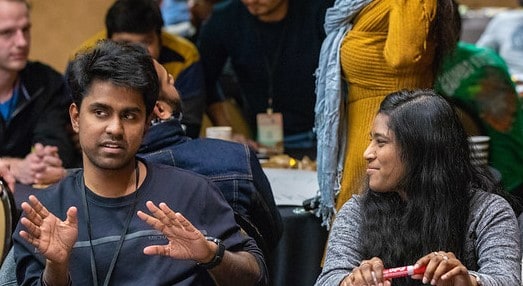Increasing numbers of South Asian international students are expressing curiosity about Jesus and the Bible. Praise God! We want to be ready to serve them and help them understand and respond to the good news. But many who are accustomed to working with East Asian students are unfamiliar with the different worldview and questions that South Asians bring. So we have compiled some tips below to help you avoid issues that are less relevant and to communicate more naturally for South Asian students.
Antiquity and Background
The roots of Hindu religions are old. Some assert it is the world’s oldest religion. But this is hard to prove since Hinduism is really a collection of religious traditions and the oldest scriptures were transmitted orally and only later written in the Sanskrit language. Western scholars date the earliest Hindu scriptures from 1500-1200 BC while Indian scholars say they are much older. [Hindu Scriptures, Nicol Macnicol] Interestingly, the earliest Hindu scriptures overlap with ancient Persian religions and mythology. By comparison, the Old Testament Scriptures were probably written between 1400 and 400 BC but could also have been passed on orally before then. [OT Documents, Walter C. Kaiser]. Bottom line: both faiths have ancient roots.
However, most Hindu students have limited knowledge of their own religious writings and even less about the Bible. Typically their knowledge of Hindu religion comes through stories that they have heard, family rituals and festivals. Christian knowledge comes from stories they have heard in grade school (most attended Catholic, English-medium schools). Hindu students may assume that Christianity is a new religion because Jesus lived just two thousand years ago and the Hindu scriptures (even Buddha) predate Christ. But they are often unaware of the antiquity of the Old Testament Scriptures and the historical connection between Jesus and the Jewish people. As we introduce them to the Bible we can help them connect the dots between the history and temple worship of the Jewish people in the Old Testament with Jesus’ fulfillment in his life, death and resurrection in the New. Hindus know that Jesus died. Few know why!
Then he opened their minds to understand the Scriptures, Luke 24:45
Begin with a shared belief in one God, the divinity of Jesus and credibility of the Bible
India is traditionally a very “spiritual” environment. Religion is a normal part of life and most acknowledge the existence of one ultimate being, the divinity of Jesus (or spiritually enlightened) and credibility of the Bible. The differences are in the definitions and uniqueness of these which they will discover for themselves. If they have objections they will usually ask. But you don’t have to answer questions they don’t have.
Note: Growing numbers of SA students are disillusioned with religions in general. These may retain a superficial allegiance to Hindu practices for the sake of family while rejecting it for themselves. So we also have to be careful not to assume beliefs that aren’t actually there.
Uniqueness of Christ
While we don’t want to begin with the most difficult questions (like hell and exclusivity) we must not avoid them either. Most Hindus already know of the exclusivity of Christianity and interpret it as cultural superiority. It is understood in terms of birth community, not personal faith. So make sure Christ and not Christianity is the issue. Help them hear the exclusive claims through the lips of Jesus rather than just through the evangelist. And help them understand the expansiveness of God’s sacrificial love in Jesus’ death–that it is for all people everywhere in every age–not just for “Christians” (those born in a “Christian” family or country)
Stories and illustrations
Stories are a common way that religious ideas and morals are taught in India. Therefore, this is a natural way for us to share the Bible–both the individual stories and the overall Story. Simple illustrations are also helpful for communicating Biblical principles. When possible start with stories of Jesus or from Genesis. You will likely find Hindus spiritually perceptive and will often pick up the meaning quickly.
Open dialogue
Allow plenty of room for sharing and questions—not simply a monologue. Due to religious tensions and sensitivity in India, Hindu students will likely find it less threatening if the environment is one of “sharing” ideas. Most Hindus have uncritically accepted the traditions and rituals that they have seen. But they may have never asked the question “Do I really believe ____?” A safe environment with open dialogue allows them to air their ideas freely while hearing new ideas. We want to encourage them to think and ask questions and let the Scripture speak for itself.
Make questions your friends
Learning to ask questions effectively is a great skill to gain. Taking the time to know them and what they think will give you insight into what is really important to them. Otherwise, we will often answer questions they do not really have or care much about. Don’t be afraid of silence. Whenever possible, let the authority be from the Bible. Don’t answer questions with your own opinions but quote or let them read from the Bible themselves. When exploring a passage of Scripture with a mixed audience (seekers and believers) it is important to ask questions that “anyone” can answer. using 5 simple questions:
- What do you like/find interesting about the story?
2. What do you not like( or find confusing or difficult)?
3. What do you learn about people from the story?
4. What do you learn about God?
5. What did you learn from the story about anything God wants you to do or not do?
Sharing and Prayer
Often what an American might call a “Bible study” South Asians will call a “prayer meeting.” This suggests that Hindus see it more holistically as a spiritual meeting and not an academic study. So allow time for prayer and fellowship together including specific prayer concerns. Ultimately, we want our friends to encounter Christ the Lord in the Scripture, in prayer, in worship and in the community of believers.
Community
India is not an individualistic culture even though globalization is fragmenting some elements of the family in urban society. If possible allow for community to grow around the exploration of Scripture through prayer, worship, and good Indian food! (In India, a meal is usually served later (8-10 pm) at the END of a function marking its conclusion.) Ideally, allow Indian students or family to host it in their apartment or home. Indian partnership and initiative is essential.
Exploring the Bible with South Asian Students
They said to each other, “Did not our hearts burn within us while he talked to us on the road, while he opened to us the Scriptures?” Luke 24:32










